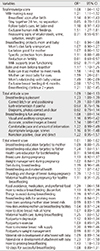1. Isaacs EB, Fischl BR, Quinn BT, Chong WK, Gadian DG, Lucas A. Impact of breast milk on intelligence quotient, brain size, and white matter development. Pediatr Res. 2010; 67(4):357–362. DOI:
10.1203/PDR.0b013e3181d026da.
2. Ip S, Chung M, Raman G, Chew P, Magula N, DeVine D, et al. Breastfeeding and maternal and infant health outcomes in developed countries. Evid Rep Technol Assess (Full Rep). 2007; 153:1–186.
4. World Health Organization. Reproductive health strategy: To accelerate progress towards the attainment of international development goals and targets [Internet]. Geneva, CH: Author;2004. cited 2014 December 5. Available from:
http://whqlibdoc.who.int/hq/2004/WHO_RHR_04.8.pdf.
5. Kim SK, Kim YK, Kim HR, Park JS, Son CK, Choi Y, et al. The 2012 national survey on fertility, family health & welfare in Korea. Seoul: Korea Institute for Health and Social Affairs;2012. p. 2012–2054. Report No.: Research Paper.
6. Ministry of Health and Welfare. The national health plan 2011-2020. Seoul: Author;2011.
7. Mete S, Yenal K, Okumuş H. An investigation into breastfeeding characteristics of mothers attending childbirth education classes. Asian Nurs Res. 2010; 4(4):216–226. DOI:
10.1016/s1976-1317(11)60006-6.
8. Jessri M, Farmer AP, Maximova K, Willows ND, Bell RC. Predictors of exclusive breastfeeding: Observations from the Alberta pregnancy outcomes and nutrition (APrON) study. BMC Pediatr. 2013; 13:77. DOI:
10.1186/1471-2431-13-77.
9. Stuebe AM, Bonuck K. What predicts intent to breastfeed exclusively? Breastfeeding knowledge, attitudes, and beliefs in a diverse urban population. Breastfeed Med. 2011; 6(6):413–420. DOI:
10.1089/bfm.2010.0088.
10. Scott JA, Kwok YY, Synnott K, Bogue J, Amarri S, Norin E, et al. A comparison of maternal attitudes to breastfeeding in public and the association with breastfeeding duration in four European countries: Results of a cohort study. Birth. 2015; 42(1):78–85. DOI:
10.1111/birt.12138.
11. Leahy-Warren P, Mulcahy H, Phelan A, Corcoran P. Factors influencing initiation and duration of breast feeding in Ireland. Midwifery. 2014; 30(3):345–352. DOI:
10.1016/j.midw.2013.01.008.
12. Dungy CI, McInnes RJ, Tappin DM, Wallis AB, Oprescu F. Infant feeding attitudes and knowledge among socioeconomically disadvantaged women in Glasgow. Matern Child Health J. 2008; 12(3):313–322. DOI:
10.1007/s10995-007-0253-9.
13. Huang MZ, Kuo SC, Avery MD, Chen W, Lin KC, Gau ML. Evaluating effects of a prenatal web-based breastfeeding education programme in Taiwan. J Clin Nurs. 2007; 16(8):1571–1579. DOI:
10.1111/j.1365-2702.2006.01843.x.
14. Gazmararian JA, Dalmida SG, Merino Y, Blake S, Thompson W, Gaydos L. What new mothers need to know: Perspectives from women and providers in Georgia. Matern Child Health J. 2014; 18(4):839–851. DOI:
10.1007/s10995-013-1308-8.
15. Romano AM. A changing landscape: Implications of pregnant women's internet use for childbirth educators. J Perinat Educ. 2007; 16(4):18–24. DOI:
10.1624/105812407x244903.
16. Thomas JR, Shaikh U. Use of electronic communication by physician breastfeeding experts for support of the breastfeeding mother. Breastfeed Med. 2012; 7(6):393–396. DOI:
10.1089/bfm.2011.0133.
17. O'Connor ME, Brown EW, Lewin LO. An internet-based education program improves breastfeeding knowledge of maternal-child healthcare providers. Breastfeed Med. 2011; 6(6):421–427. DOI:
10.1089/bfm.2010.0061.
18. Ahmed AH, Ouzzani M. Interactive web-based breastfeeding monitoring: Feasibility, usability, and acceptability. J Hum Lact. 2012; 28(4):468–475. DOI:
10.1177/0890334412451869.
19. Williams EL, Hammer LD. Breastfeeding attitudes and knowledge of pediatricians-in-training. Am J Prev Med. 1995; 11(1):26–33.
20. Smith LJ. A score sheet for evaluating breastfeeding educational materials. J Hum Lact. 1995; 11(4):307–311.
21. Kim KN, Hyun T, Kang NM. A survey on the feeding practices of women for the development of a breastfeeding education program: Breastfeeding knowledge and breastfeeding rates. Korean J Community Nutr. 2002; 7(3):345–353.
22. Kramer MS, Kakuma R. Optimal duration of exclusive breastfeeding. Cochrane Database Syst Rev. 2012; 8:CD003517. DOI:
10.1002/14651858.CD003517.pub2.
23. Persad MD, Mensinger JL. Maternal breastfeeding attitudes: Association with breastfeeding intent and socio-demographics among urban primiparas. J Community Health. 2008; 33(2):53–60. DOI:
10.1007/s10900-007-9068-2.
24. Onah S, Osuorah DI, Ebenebe J, Ezechukwu C, Ekwochi U, Ndukwu I. Infant feeding practices and maternal socio-demographic factors that influence practice of exclusive breastfeeding among mothers in Nnewi South-East Nigeria: A cross-sectional and analytical study. Int Breastfeed J. 2014; 9:6. DOI:
10.1186/1746-4358-9-6.
25. Johnston ML, Esposito N. Barriers and facilitators for breastfeeding among working women in the United States. J Obstet Gynecol Neonatal Nurs. 2007; 36(1):9–20. DOI:
10.1111/j.1552-6909.2006.00109.x.
26. Salonen AH, Pridham KF, Brown RL, Kaunonen M. Impact of an internet-based intervention on Finnish mothers' perceptions of parenting satisfaction, infant centrality and depressive symptoms during the postpartum year. Midwifery. 2013; 30(1):112–122. DOI:
10.1016/j.midw.2013.02.009.
27. Kornides M, Kitsantas P. Evaluation of breastfeeding promotion, support, and knowledge of benefits on breastfeeding outcomes. J Child Health Care. 2013; 17(3):264–273. DOI:
10.1177/1367493512461460.
28. Kim HR. Breastfeeding trends, affecting factors and poilicy options for breastfeeding promotion in Korea. Health Welf Policy Forum. 2013; 201:49–60.
29. Li R, Scanlon KS, Serdula MK. The validity and reliability of maternal recall of breastfeeding practice. Nutr Rev. 2005; 63(4):103–110.
30. Ministry of Health & Welfare. Korea Centers for Disease Control & Prevention. Korea health statistics 2009: Korea national health and nutrition examination survey (KNHANES IV-3). Seoul: Ministry of Health & Welfare;2010.







 PDF
PDF ePub
ePub Citation
Citation Print
Print



 XML Download
XML Download